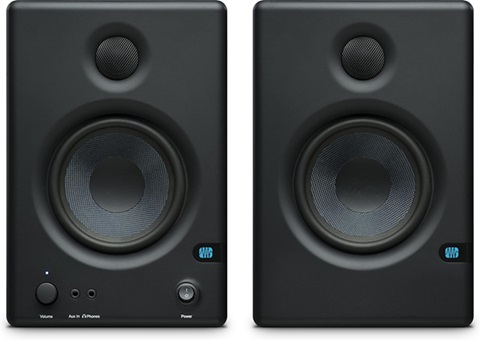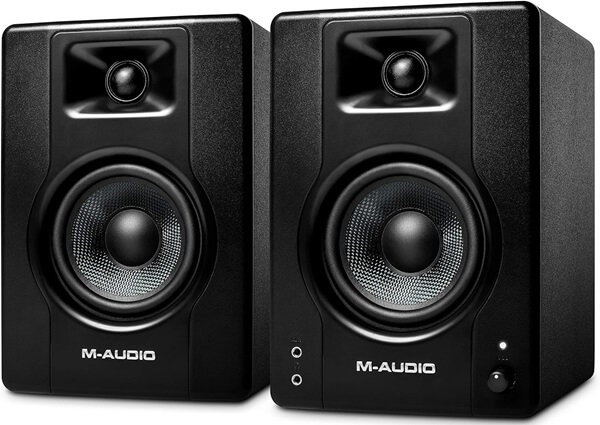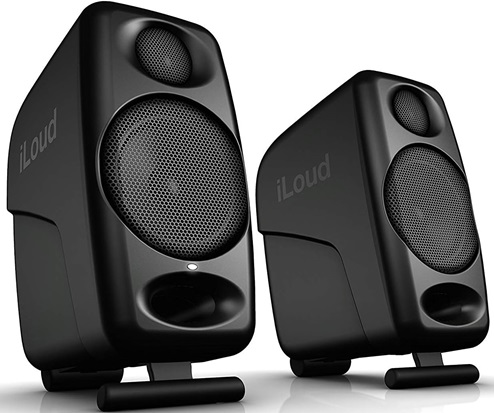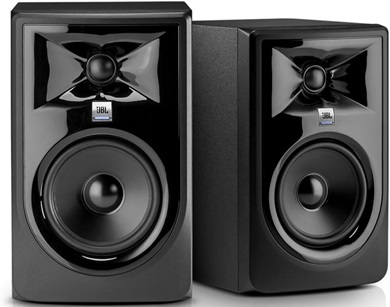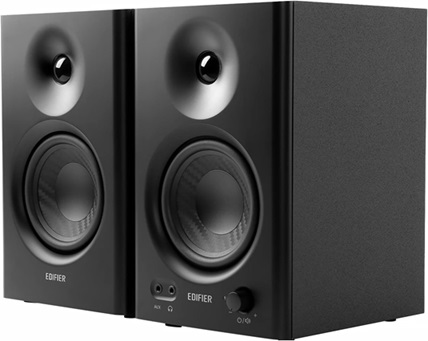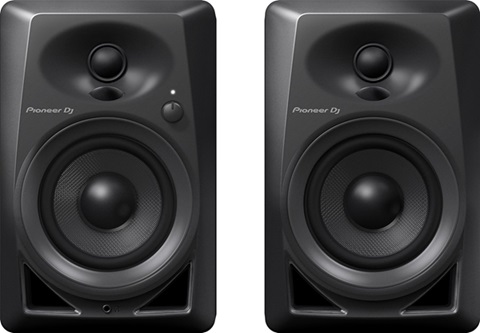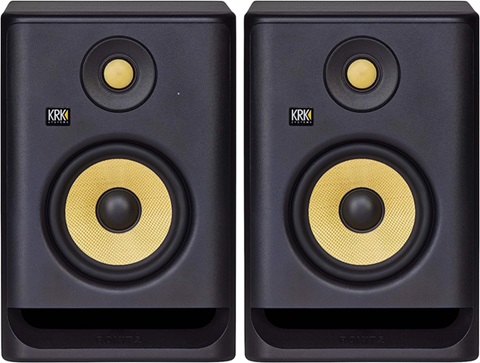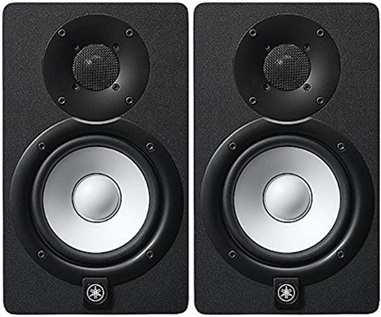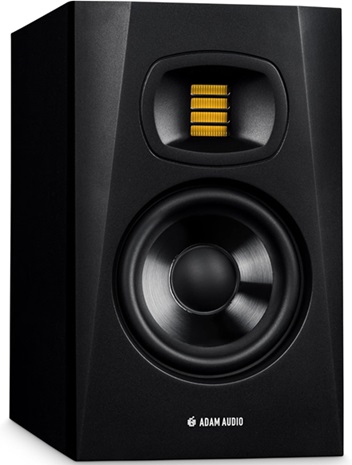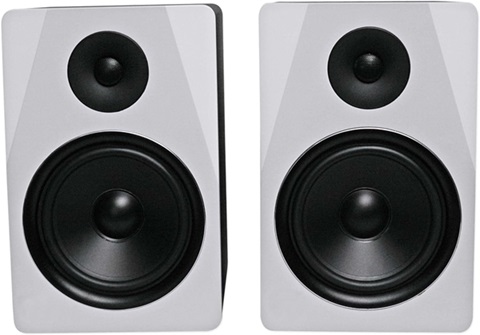Studio monitors play a vital role in audio production, especially when it comes to the precision required for mixing and mastering. The purpose of built-in speakers is to reproduce sound accurately, providing the clarity to make you informed decisions about your audio creations. If you are mixing and mastering electronic music, you will need monitors that can reproduce low frequencies accurately. If you are mixing and mastering acoustic music, you will need monitors that can reproduce high frequencies accurately.
Here are some of the top features to look for when buying studio monitors for mixing and mastering
- Driver Types and its Sizes: Studio monitors typically employ two types of drivers- woofers for low frequencies and tweeters for high frequencies. The driver size directly impacts the monitor’s frequency response. Larger drivers tend to produce lower frequencies, while smaller drivers handle higher frequencies.
- Frequency Response: Frequency response defines the range of frequencies a monitor can accurately reproduce. A broader frequency response lets you hear more of the sonic spectrum, which is beneficial for mixing and mastering. However, keep in mind that a wide frequency range doesn’t guarantee great sound; accuracy matters.
- Power: The power of a monitor will determine how loud it can play. If you are working in a large room, you will need a monitor with more power. However, if you are working in a small room, you may not need a monitor with as much power.
To help you choose the best studio monitors for your mixing and mastering needs, we will provide a comprehensive “Buying Guide”. This guide covers essential factors like driver types and sizes, frequency response, and power capacity, all designed to fill your workspace with sound. Let’s take a closer look at these critical features tailored to the art of mixing and mastering.
Outline
ToggleBest Studio Monitors for Mixing and Mastering Table
| Studio Monitors for Mixing and Mastering | Driver Types and its Sizes | Frequency Response | Power | Buy Now |
|---|---|---|---|---|
| PreSonus Studio Monitor | 4.5-inch woven-composite woofer and 1-inch silk-dome tweeter | 70 Hz to 20 kHz | 50W | Check On Amazon |
| M-Audio Studio Monitor | 4.5” Kevlar low frequency drivers and 1” natural silk dome tweeters | 69 Hz – 22 kHz | 120W | Check On Amazon |
| IK Multimedia Studio Monitor | 3/4” silk dome tweeter | 55Hz to 20kHz | 50W | Check On Amazon |
| JBL Studio Monitor | 5 Inch Softdome | 49 Hz – 20 kHz | 82W | Check On Amazon |
| Edifier Studio Monitor | 4-inch composite woofers, 1-inch silk dome tweeters | 60Hz-20KHz | 42W | Check On Amazon |
| Pioneer DJ Studio Monitor | 4-inch Fiberglass woofers, ¾-inch Soft Dome tweeters | 70Hz to 30kHz | 40W | Check On Amazon |
| KRK Studio Monitor | 5” matching woofer and 1” tweeter made with Kevlar | 43Hz-40KHz | 55W | Check On Amazon |
| Yamaha Studio Monitor | 5" cone woofer and 1" dome tweeter | 54Hz-30kHz | 70W | Check On Amazon |
| ADAM Audio Studio Monitor | Polypropylene 7” woofer, 1.9” Accelerated Ribbon Tweeter | 39 Hz-25 kHz | 7OW | Check On Amazon |
| Rockville Studio Monitor | 8" woofer, 1" neodymium silk dome tweeter | 30Hz-20 kHz | 250W | Check On Amazon |
Best Studio Monitors for Mixing and Mastering Reviews
1. PreSonus Studio Monitor
PreSonus introduces the Eris E4.5 studio monitors, catering to music enthusiasts, content creators, and gamers seeking compact studio-quality sound. These monitors feature a 4.5-inch woven-composite woofer and a 1-inch silk-dome tweeter, delivering precise and balanced sound across the frequency spectrum.
With 50W of Class AB amplification, they offer sufficient volume and headroom, making them suitable for nearfield monitoring. Setting up and using the E4.5s is straightforward, thanks to multiple connectivity options, including stereo 1/8″, balanced ¼” TRS, and unbalanced RCA inputs. The front-panel volume control and headphone jack add convenience for level adjustments and private listening.
Notably, the E4.5s feature low- and high-frequency tuning controls for fine-tuning the sound to match your room acoustics and preferences. PreSonus provides a reliable warranty and accessible customer support, ensuring assistance whenever needed.
Best Features
- 4.5-inch woofer and 1-inch tweeter
- 50W total power
- Multiple input options
- 1/8″ headphone output
Pros
- Sound is neutral
- Very accurate sound stage
- The acoustic tuning to adjust for the environment
- aux in on front
Cons
- The cables you get are pretty mediocre
2. M-Audio Studio Monitor
The M-Audio BX4 4.5 studio monitors feature a 4.5-inch Kevlar woofer and a 1-inch silk dome tweeter, delivering clear, accurate, and well-defined audio. The computer-optimized tweeter waveguide enhances sound imaging, ensuring a professional listening experience.
These monitors offer high and low EQ settings for sound adjustment, while rear ports enhance bass depth. They provide versatile connectivity with 1/4″, 1/8″, and RCA inputs, simplifying device connections.
With 120W of power, the M-Audio BX4 4.5 studio monitors deliver an immersive audio experience, suitable for a range of applications, from gaming to music production. Backed by a reliable warranty, they combine precision, power, and professional sound in a versatile package.
Best Features
- Wide frequency response (50Hz-22kHz)
- 120W of power
- 4.5-inch Kevlar woofer and 1-inch silk dome tweeter
- High and low EQ settings for sound customization
Pros
- Multiple inputs
- Great Sound
- Ability to power off the volume knob
Cons
- Audio Issues When We Connect Aux Port
3. IK Multimedia Studio Monitor
IK Multimedia iLoud Micro Monitors are finely tuned, ensuring a true linear frequency response for accurate sound reproduction.
They offer pinpoint sound accuracy with DSP adjustments for bass, treble, and positioning. A standout feature is their easy Bluetooth connectivity for wireless audio streaming. With 50W RMS power, they deliver a remarkable low-end response down to 55Hz, enriching your music quality.
They connect to various devices through Bluetooth, stereo RCA, and 1/8″ aux inputs. Portable and lightweight, they’re perfect for musicians on the move, guaranteeing precise sound reproduction in any setting and versatile connectivity. Your purchase is supported by a solid warranty and accessible customer support. Enhance your sound with the IK Multimedia iLoud Micro Monitor, where advanced technology meets excellence.
Best Features
- Wide Frequency Range (55Hz – 20kHz)
- Powerful Bass (50W RMS)
- Versatile Inputs (RCA and 1/8″ aux)
- Bluetooth Connectivity
Pros
- Great Sound for Compact Speaker
- Excellent to be used with digital piano
- Bass output will satisfy
- Portable
Cons
- The power button is a bit hard
4. JBL Studio Monitor
JBL Studio Monitors are designed to deliver exceptional audio experiences, they excel in precise sound reproduction with updated transducers that capture every detail. A new boundary EQ feature ensures balanced low-frequency sound.
These monitors offer an expansive sweet spot, allowing optimal sound quality even when not directly in front of them. Their sleek, modern design enhances your studio’s aesthetics. The Image Control Waveguide guarantees clear sound and a wide listening area, powered by dual custom Class-D amplifiers for strong audio.
Connectivity is easy through balanced XLR and 1/4″ TRS inputs. These monitors provide precise sound across a wide frequency range, from 49Hz to 20kHz, and are backed by JBL’s reliable warranty. They set a new benchmark for top-quality audio, combining advanced technology, stylish design, and timeless sound excellence.
Best Features
- Balanced XLR and 1/4″ TRS inputs.
- Wide frequency response and high SPL
- Enhanced transducers for superior sound.
- Boundary EQ for balanced low-frequency response
- Dual custom amplifiers for powerful output
Pros
- No Subwoofer needed
- Good Build Quality and Sound
- Excellent Speakers with TRS Input
- Best Value for Home Studios
Cons
- They don’t perform as great at low-volume
5. Edifier Studio Monitor
Edifier MR4 Powered Studio Monitor features a 4-inch composite woofer and a 1-inch silk dome tweeter, delivering high-quality sound with 21W of power per speaker.
They offer clear and precise audio across a broad frequency range from 60Hz to 20KHz. Connectivity is effortless with balanced TRS, unbalanced RCA, and AUX inputs, along with a front headphone output for private listening. The dual design mode allows you to switch between different sound profiles to suit your needs.
These monitors excel in sound accuracy, making them ideal for music production, mixing, and mastering, providing an enjoyable listening experience for your daily music sessions. The easy-to-use controls allow adjustments for high and low frequencies, volume, and sound modes. Backed by reliable customer support, the MR4 studio monitors offer accurate sound and versatile connections, catering to both professionals and music enthusiasts.
Best Features
- 4-inch composite woofer and 1-inch silk dome tweeter.
- Versatile connectivity with balanced TRS, unbalanced RCA, and AUX inputs.
- Dual-mode design for studio and casual listening.
- Easy controls for sound adjustments.
- Accurate sound reproduction for various tasks.
Pros
- Ports in front
- DSP inside is pristine.
- Fantastic for PC gaming and general media
- Good sound quality
Cons
- Bluetooth Connectivity Issues
6. Pioneer DJ Studio Monitor
The Pioneer DM-40 4″ Studio monitors are powered by 2 x 21W amplifiers, ensuring a punchy performance with 4-inch fiberglass woofers and ¾-inch soft dome tweeters. They boast a wide frequency response, covering from 70Hz to 30KHz, capturing every detail in your music.
Featuring a front-loaded bass reflex for rich and tight bass and DECO technology for an immersive listening experience, they prioritize sound quality. Time alignment minimizes distortion, and Pioneer’s design reduces resonance, further enhancing sound quality.
In terms of connectivity, these monitors offer multiple options, including a headphone output and RCA/Stereo mini jack inputs. Whether you’re a DJ, a music producer, or simply enjoying music at home, the Pioneer DM-40 is an ideal choice.
Best Features
- High-quality 2 x 21W amplifiers.
- 4-inch fiberglass woofers and ¾-inch soft dome tweeters.
- Front-loaded bass reflex system.
- DECO technology for a wide sweet spot.
- Time alignment for low-distortion sound.
Pros
- Very Clear Sound, Powerful Monitor Speakers
- Reasonable Price
- Best Speakers for Home Studio
- Great intro to DJ Monitors
Cons
- They include an automatic shutdown that requires a restart(Timeout feature)
7. KRK Studio Monitor
KRK RP5 Rokit 5 G4, a pair of 5″ powered studio monitors are Ideal for experts, musicians, and audio enthusiasts, these monitors feature a 5.25″ Kevlar Aramid Fiber woofer and a 1″ Kevlar Aramid Fiber tweeter, covering a wide frequency range from 43Hz to 40kHz for precise and consistent sound reproduction.
Powered by a Class D Amplifier, they handle tasks with ease. The DSP-driven EQ offers 25 settings for audio fine-tuning, adapting to your specific listening space. The front speaker design enhances bass, while the monitor’s build maintains clear sound without distortion. Foam pads underneath reduce vibrations for an exceptional listening experience.
For advanced EQ calibration and room analysis, the KRK app for iOS and Android is a trusted companion. With versatile connectivity options and easy setup, these monitors are an excellent choice for those who demand the best. Backed by a reliable warranty, the KRK RP5 Rokit 5 G4 is expertly designed to deliver the ultimate sound experience.
Best Features
- Powerful built-in Class D amplifier
- Wide frequency range
- Visual EQ control with LCD screen
- Enhanced front-firing bass response
Pros
- Excellent quality sound
- Good Sound in Small Cabinet
- Quality Bass
- Standard for Home Studio/Industry
Cons
- On/Off switch is on the back
8. Yamaha Studio Monitor
The Yamaha HS5 studio monitor features advanced transducers for a wide and precise response, with dedicated amplifiers ensuring consistent, high-resolution sound. User-friendly response controls allow easy adjustment to your listening environment.
Crafted with top-quality materials, the HS5 minimizes unwanted resonance within its dense cabinet, supported by advanced noise reduction technology for enhanced sound clarity. With various connectivity options, setup is hassle-free. These monitors feature a 5-inch cone woofer and a 1-inch dome tweeter, offering a frequency response of 54Hz – 30kHz, powered by 70W of total output. XLR and TRS phone jack inputs provide versatile connectivity.
Backed by Yamaha’s legacy of excellence, the HS5 offers professional-grade sound quality, and it comes with a reliable warranty and responsive customer support. Enhance your sound with the Yamaha HS5 and enjoy top-notch audio from a brand that prioritizes your experience.
Best Features
- Exceptional Sound Quality
- Bi-Amp Design
- User-Friendly Response Controls
- Advanced Noise Reduction
- Easy Setup
Pros
- Crystal Clear Sound
- Great for Keyboard Playing at home
- Transparent pair of monitors
- Great when coupled with their subwoofer
Cons
- Need an external amplifier
9. ADAM Audio Studio Monitor
The ADAM Audio T7V studio monitor is tailored for music production, video post-production, and broadcasting. Despite its compact size, this monitor packs a punch with a 7-inch woofer and a 1.9-inch U-ART tweeter.
Featuring a broad sweet spot thanks to its HPS waveguide, it allows for sound adjustments to suit your specific space using high and low-shelf DSP filters. From the trusted ADAM Audio, the T7V offers a 39Hz-25kHz frequency response and 70W RMS power, ensuring versatility in setup and usage with multiple connectivity options, including XLR and RCA inputs.
ADAM Audio stands behind your investment with reliable customer support. The T7V is designed to deliver professional-grade sound, making it the preferred choice for those seeking to enhance their audio experience.
Best Features
- High-Quality Sound
- Advanced Tweeter
- Wide Sweet Spot
- DSP-Based Filters
Pros
- Amazing for Editing Videos
- Great mid-bass punch
- Great for Home Studio
- Dynamic Tweeter
Cons
- No Center Mark on the Volume Control
10. Rockville Studio Monitor
The Rockville APM8W studio monitors ensure precision sound for critical listening. With a robust 500-watt peak power per pair, these monitors can fill any room with rich and detailed sound. Their quad amp design guarantees that each driver receives the necessary power for optimal performance. The electronic crossover network seamlessly blends the woofer and tweeter for a natural soundstage.
Versatility is a key feature of the APM8W monitors, offering connectivity options such as USB, RCA, 1/4″, and XLR inputs, along with a 3.5mm headphone output, ensuring compatibility with a wide range of audio devices. The APM8W’s durable wooden enclosure and rear-firing port reduce distortion for clear sound. They provide a range of advanced features suitable for professionals and come with a reliable warranty and support for your peace of mind. Enhance your sound quality with the Rockville APM8W, designed for professional-grade sound precision.
Best Features
- Accurate and detailed sound reproduction.
- Powerful 500W peak power.
- Quad amp design.
- Computer-optimized crossover network.
- Versatile connectivity options.
- Durable wooden enclosure with rear-firing port.
Pros
- Great for Producing and Mixing
- Excellent sound quality and clarity along with the cabinet design
- Extremely clear studio monitors, full bass, clean mids and highs
Cons
- No Power Cord Included
Buying Guide for Best Studio Monitors for Mixing and Mastering
Studio monitors are essential tools for mixing and mastering audio. They provide accurate and reliable sound reproduction, allowing you to hear your mixes in all their detail. When choosing studio monitors, it is important to consider the following factors:
1. Driver Types and its Sizes
Studio monitors typically use two types of drivers: woofers and tweeters. Woofers reproduce low frequencies, while tweeters reproduce high frequencies. The size of the driver determines the frequency range it can reproduce. Larger woofers can reproduce lower frequencies, while smaller tweeters can reproduce higher frequencies.
For mixing and mastering, it is important to choose studio monitors with drivers that can reproduce the entire frequency range of human hearing (20Hz-20kHz). This will allow you to hear your mixes accurately and make informed decisions about your mix.
2. Frequency Response
Frequency response is the range of frequencies that a speaker can reproduce. It is measured in hertz (Hz). The frequency response of studio monitors should be as flat as possible, meaning that they should reproduce all frequencies evenly.
A flat frequency response is important for mixing and mastering because it allows you to hear your mixes accurately. If the frequency response of your studio monitors is not flat, you may boost or cut certain frequencies in your mix without realizing it.
3. Power
Power is the amount of electrical energy that a speaker can handle. It is measured in watts (W). The power of studio monitors should be sufficient for the size of your room and the volume level at which you work.
If you are working in a small room, you do not need studio monitors with a lot of power. However, if you are working in a large room or at high volume levels, you will need studio monitors with more power.
4. Connectivity Technology
Studio monitors come with a variety of connectivity options, including XLR, TRS, RCA, and Bluetooth. It is important to choose studio monitors with connectivity options that are compatible with your audio equipment.
Bluetooth is a wireless connectivity technology that allows you to connect your studio monitors to your computer or other audio devices without using cables. This can be a convenient option if you want to eliminate the clutter of cables in your studio.
Analog inputs and outputs are also important considerations when choosing studio monitors. Analog inputs allow you to connect your studio monitors to audio devices that do not have digital outputs, such as record players and cassette decks. Analog outputs allow you to connect your studio monitors to audio devices such as headphones and speakers.
5. Warranty
Studio monitors are a significant investment, so it is important to choose studio monitors with a good warranty. A good warranty will protect you in case of any defects with your studio monitors.
Studio Monitors for Mixing and Mastering – FAQs
Ans: Studio monitors (some call them studio speakers or reference loudspeakers) are specifically designed for use in recording studios at radio stations and other professional audio environments. They’re used to mix music, dialogue, and sound effects during the recording, mixing, and mastering process.
Ans: It never hurts to have multiple pairs of monitors so you can compare your mix on different speakers — each speaker sounds different, so listening on multiple models can help you create a more transportable mix that sounds good on any speaker.
Ans: 75 dB to 85 dB SPL depending on room size; the larger the room the louder you’ll have to mix within the recommended range. Investing in a top-notch dB meter will ensure you can keep an eye on your own mixes, though beware, mixing at loud levels can cause ear fatigue or worse damage your hearing.
Ans: In two-way monitors, the woofer is also tasked with handling some of the lower- mid-range frequencies, while three-way monitors reduce the driver’s workload and therefore allow the woofer to focus on the bass.
Ans: Because you’re hearing the bass buildup in the room, not the “real” bass coming out of the speakers. Place the speakers a minimum of 6 to 10 inches away from the wall — 2-3 feet is better; this will minimize bass buildup from the front wall.
Ans: They are just strictly not needed for the recording process itself. I spend my first years mixing/recording on a set of regular B&W speakers. They will produce sound, but not be honest with you. They do not need to be expensive.
Ans: The amount of time it takes to master a song can vary greatly, but it’s common for pros to spend anywhere from 30 to 90 minutes mastering a single track. Sure, there are pros out there who can crank out great masters in 5 or 10 minutes, but most of us will need a little more time.
Conclusion
Choosing the right studio monitors for mixing and mastering is essential to creating high-quality audio. Studio monitors should provide accurate and reliable sound reproduction across the entire frequency spectrum so that you can hear your mixes in all their detail and make informed decisions about your mix.
- JBL Studio Monitor is a popular choice among professional producers and engineers for its accurate sound reproduction, wide frequency response, and powerful bass response. It is also relatively affordable, making it a great value for the money.
- PreSonus Studio Monitor is a good option for beginners or those on a budget. It offers good sound quality for its price.
- Rockville Studio Monitor is the most powerful on the list, with 500 watts peak power per pair. This makes them a good choice for large rooms and for people who need to mix and master at high volume levels.

